Welcome to our free classical music site

Do you write about classical music? Are you a blogger? Want to team up with Classical Connect? Send us a message, let's talk!

Do you write about classical music? Are you a blogger? Want to team up with Classical Connect? Send us a message, let's talk!
November 20, 2017. Penderecki. Krzysztof Penderecki, one of the best known Polish composers of the 20th century, was born on November 23rd of 1933 in the small town of Dębica in southeastern Poland. The town’s name in Yiddish was Dembitz, and before WWII the majority of the population was Jewish – later, Penderecki would use Jewish music in several compositions. In addition to Polish,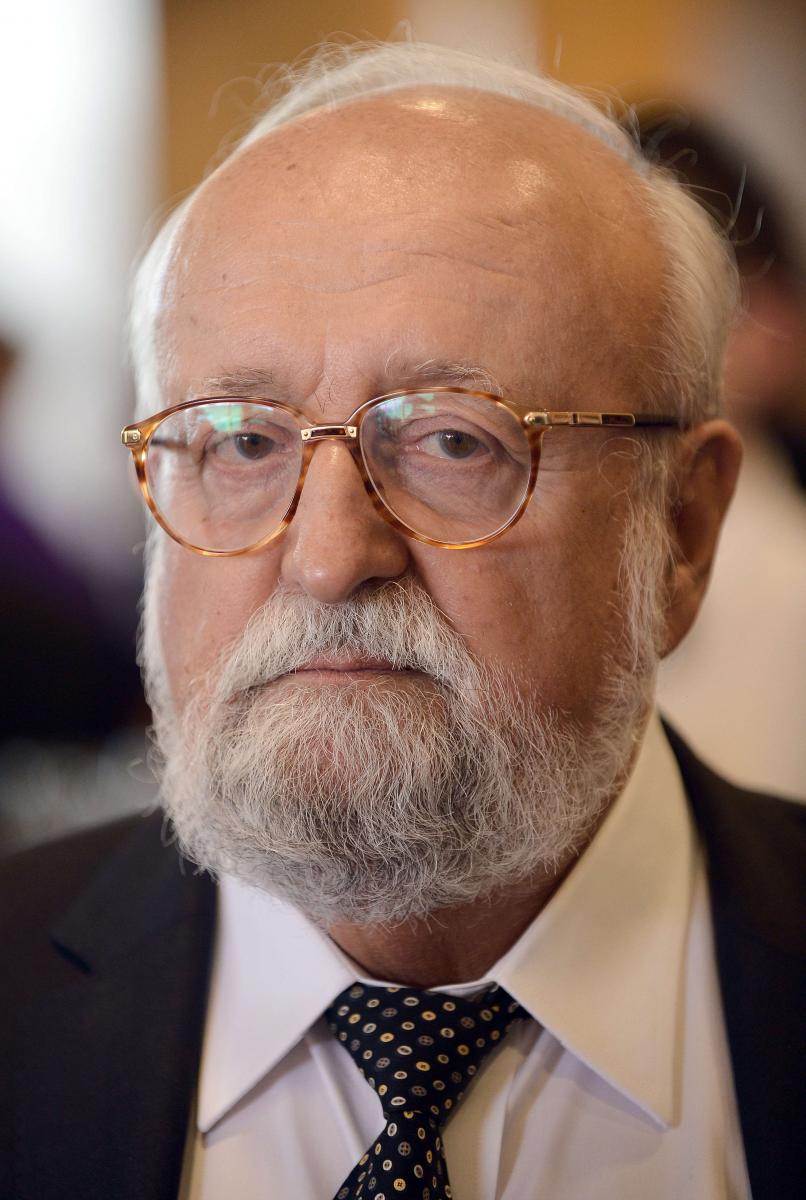 Penderecki’s family had Armenian and German roots. The family wasn’t musical, but, as was customary in educated families of the time, Krzysztof took piano lessons. Somebody presented Krzysztof’s father with a violin, and the boy took a liking to the instrument. In 1951 Penderecki moved to Krakow, attending Jagiellonian University first, and then transferring to the Academy of Music. There he studied the violin for one year, but then switched completely to composition. He graduated in 1958 and one year later received three awards for three compositions he submitted to the young composers’ competition, organized by the Polish Composers’ Union. His Strofy (‘Strophes’) received the first prize, and Emanacje (‘Emanations’) and Psalmy Dawida (‘Psalms of David’) shared the second. All compositions were submitted anonymously, and the jury didn’t know that all winning entries were written by the same composer. Since 1956, when Poland opened up after years of Stalinism, cultural life became less controlled. While still a Communist state, culturally Poland was the freest country in the Soviet bloc. New music could be performed, and music of young composers could be heard in the West. One person who became familiar with Penderecki’s work was Heinrich Strobel, principal of the Music Department of the Südwestrundfunk (SWR) Symphony Orchestra of Baden-Baden, one of the leading new Music ensembles. Strobel, a champion of Pierre Boulez and Karlheinz Stockhausen, became a promoter of the works of Krzysztof Penderecki. In 1960, Penderecki’s popularity in the West lead to an interesting episode. He had just completed a piece he initially called 8’37”, for the exact performing duration of the composition, which he later renamed Threnody to the Victims of Hiroshima. The piece, scored for 52 string instruments, required unorthodox performing technique, like unusual glissandos, playing on the tailpiece, etc. This, in turn, required unconventional notation, which Penderecki invented
Penderecki’s family had Armenian and German roots. The family wasn’t musical, but, as was customary in educated families of the time, Krzysztof took piano lessons. Somebody presented Krzysztof’s father with a violin, and the boy took a liking to the instrument. In 1951 Penderecki moved to Krakow, attending Jagiellonian University first, and then transferring to the Academy of Music. There he studied the violin for one year, but then switched completely to composition. He graduated in 1958 and one year later received three awards for three compositions he submitted to the young composers’ competition, organized by the Polish Composers’ Union. His Strofy (‘Strophes’) received the first prize, and Emanacje (‘Emanations’) and Psalmy Dawida (‘Psalms of David’) shared the second. All compositions were submitted anonymously, and the jury didn’t know that all winning entries were written by the same composer. Since 1956, when Poland opened up after years of Stalinism, cultural life became less controlled. While still a Communist state, culturally Poland was the freest country in the Soviet bloc. New music could be performed, and music of young composers could be heard in the West. One person who became familiar with Penderecki’s work was Heinrich Strobel, principal of the Music Department of the Südwestrundfunk (SWR) Symphony Orchestra of Baden-Baden, one of the leading new Music ensembles. Strobel, a champion of Pierre Boulez and Karlheinz Stockhausen, became a promoter of the works of Krzysztof Penderecki. In 1960, Penderecki’s popularity in the West lead to an interesting episode. He had just completed a piece he initially called 8’37”, for the exact performing duration of the composition, which he later renamed Threnody to the Victims of Hiroshima. The piece, scored for 52 string instruments, required unorthodox performing technique, like unusual glissandos, playing on the tailpiece, etc. This, in turn, required unconventional notation, which Penderecki invented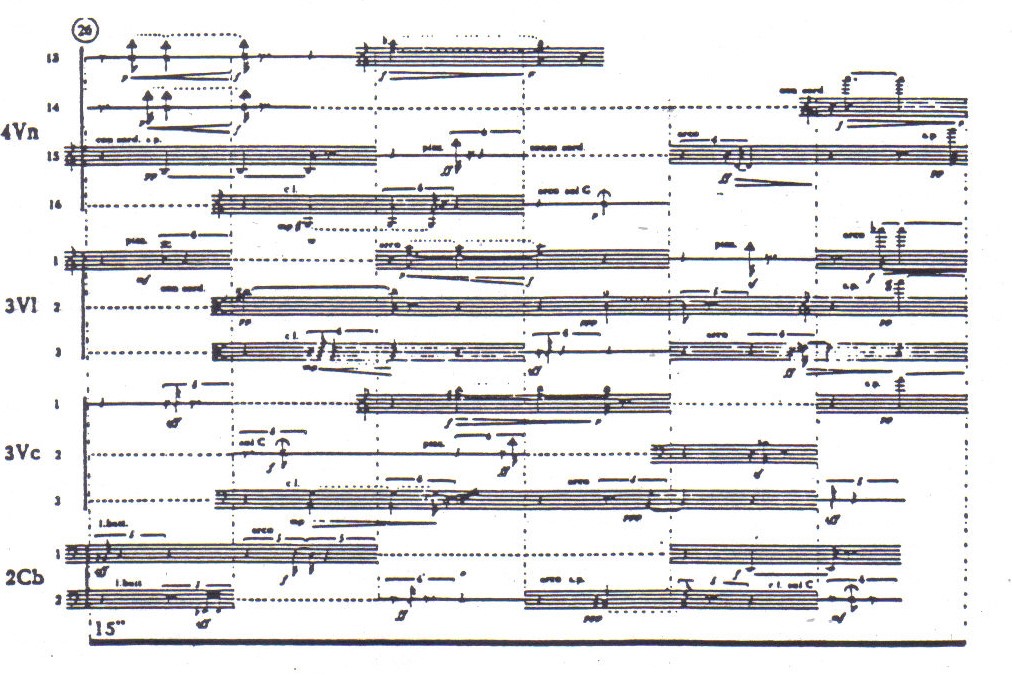 himself. The notation created many problems, as musicians couldn’t figure out what was required of them; Penderecki had to work with the orchestras to explain his intent (you can see a small excerpt on the right). When several European ensembles decided to perform Trenody, Penderecki sent the score to his German publisher. The package never arrived, apparently it got lost in the mail, and Penderecki had to recreate it from memory. Sometime later the score reappeared and was delivered то the addressee. When the two versions were compared, it turned out that they were identical. This provides wonderful proof of the exactness of Penderecki’s intent, the music of necessity of every note despite the seeming chaos of the twelve-tone composition. But the story doesn’t end there. Later, the reason for the score’s long delay was discovered: the custom officials who examined the unusual notation decided that it couldn’t have been music; they suspected that it was a document containing some encoded secret information, probably of military or political significance. Only after a lengthy examination did they discover that this indeed was a music score and sent it to the publisher. Here’s Trenody in the performance by the National Polish Radio Symphony Orchestra, Antoni Wit conducting.
himself. The notation created many problems, as musicians couldn’t figure out what was required of them; Penderecki had to work with the orchestras to explain his intent (you can see a small excerpt on the right). When several European ensembles decided to perform Trenody, Penderecki sent the score to his German publisher. The package never arrived, apparently it got lost in the mail, and Penderecki had to recreate it from memory. Sometime later the score reappeared and was delivered то the addressee. When the two versions were compared, it turned out that they were identical. This provides wonderful proof of the exactness of Penderecki’s intent, the music of necessity of every note despite the seeming chaos of the twelve-tone composition. But the story doesn’t end there. Later, the reason for the score’s long delay was discovered: the custom officials who examined the unusual notation decided that it couldn’t have been music; they suspected that it was a document containing some encoded secret information, probably of military or political significance. Only after a lengthy examination did they discover that this indeed was a music score and sent it to the publisher. Here’s Trenody in the performance by the National Polish Radio Symphony Orchestra, Antoni Wit conducting.
Around 1975 Penderecki’s style, which up to then had been very much modernist, underwent a considerable change and became more melodic, in a neo-romantic way. So different is his music written in the second half of his career that we’ll have to address it separately.Permalink
November 13, 2017. Couperin and Cziffra. During the two weeks that we’ve beenpreoccupied with one photograph, we missed several anniversaries that are clearly worth mentioning.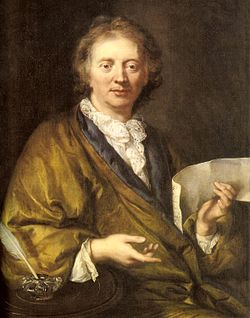 was born on November 10th of 1668 (we’ve written about him a number of times, for example here and here). One of the greatest French composers of the Baroque era, he was especially famous for his harpsichord music. Since the advent of the modern piano, his works are as often performed on this instrument as on the “clavecin,” for which these works were originally written. Here, for example, is Les Barricades Mystérieuses, the title as mysterious as are the barricades in question. It’s the fifth piece in Couperin’s "Ordre 6ème de clavecin." It’s performed by György Cziffra, whose birthday was last week. Cziffra, a piano virtuoso with an unusual biography, was born on November 5th of 1921 into a family of a poor gipsy cabaret performer. His father, a cimbalom player, lived in Paris in the 1910s but was expelled from France as a citizen of an enemy state. György started playing piano at a very early age, imitating his older sister. At the age of five he was already earning money in bars and circuses, playing piano improvisations on melodies suggested by customers. At the age of nine he entered the Franz Liszt Academy of Music in Budapest, becoming their youngest student ever. One of his teachers was the composer Ernst von Dohnányi. At the age of 12 György was performing across Hungary, and at 16 went on a tour of the Netherlands and Scandinavia. In 1942 Cziffra was conscripted, as Hungary was fighting on Nazi Germany’s side in WWII. He was captured by the Soviet partisans and imprisoned till after the war. He returned to Budapest in 1947 and, penniless, had to earn money playing piano in bars and clubs.
was born on November 10th of 1668 (we’ve written about him a number of times, for example here and here). One of the greatest French composers of the Baroque era, he was especially famous for his harpsichord music. Since the advent of the modern piano, his works are as often performed on this instrument as on the “clavecin,” for which these works were originally written. Here, for example, is Les Barricades Mystérieuses, the title as mysterious as are the barricades in question. It’s the fifth piece in Couperin’s "Ordre 6ème de clavecin." It’s performed by György Cziffra, whose birthday was last week. Cziffra, a piano virtuoso with an unusual biography, was born on November 5th of 1921 into a family of a poor gipsy cabaret performer. His father, a cimbalom player, lived in Paris in the 1910s but was expelled from France as a citizen of an enemy state. György started playing piano at a very early age, imitating his older sister. At the age of five he was already earning money in bars and circuses, playing piano improvisations on melodies suggested by customers. At the age of nine he entered the Franz Liszt Academy of Music in Budapest, becoming their youngest student ever. One of his teachers was the composer Ernst von Dohnányi. At the age of 12 György was performing across Hungary, and at 16 went on a tour of the Netherlands and Scandinavia. In 1942 Cziffra was conscripted, as Hungary was fighting on Nazi Germany’s side in WWII. He was captured by the Soviet partisans and imprisoned till after the war. He returned to Budapest in 1947 and, penniless, had to earn money playing piano in bars and clubs. 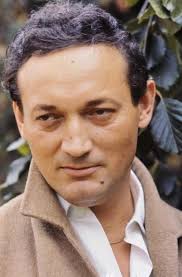 In 1950 he attempted to escape communist Hungary but was captured and imprisoned again. His guards, knowing that he was a pianist, beat his hands and wrists. He was released in 1953. The physical recovery was slow (for the rest of his life he performed with a leather band on his wrist to support ligaments damaged in prison), but two years later he was in good enough form to win the 1955 Franz List competition in Budapest. In 1956, during the Hungarian Uprising, Cziffra escaped to Vienna, where he gave a well-received recital later that year, and then moved to Paris. Cziffra played across Europe and in the US. In 1977 he set up a Cziffra Foundation in Senlis, France, in support of young musicians. Cziffra, with his tremendous technical skills, was acknowledged as a great interpreter of the works of Liszt. Here’s another piece by Couperin, L'Anguille (The eel). And here is Liszt’s Tarantella, from Venezia e Napoli section of Années de pèlerinage. Cziffra, who by the end of his life was suffering of lung cancer, died of a heart attack in Longpont-sur-Orge, outside of Paris, on January 15th of 1994.
In 1950 he attempted to escape communist Hungary but was captured and imprisoned again. His guards, knowing that he was a pianist, beat his hands and wrists. He was released in 1953. The physical recovery was slow (for the rest of his life he performed with a leather band on his wrist to support ligaments damaged in prison), but two years later he was in good enough form to win the 1955 Franz List competition in Budapest. In 1956, during the Hungarian Uprising, Cziffra escaped to Vienna, where he gave a well-received recital later that year, and then moved to Paris. Cziffra played across Europe and in the US. In 1977 he set up a Cziffra Foundation in Senlis, France, in support of young musicians. Cziffra, with his tremendous technical skills, was acknowledged as a great interpreter of the works of Liszt. Here’s another piece by Couperin, L'Anguille (The eel). And here is Liszt’s Tarantella, from Venezia e Napoli section of Années de pèlerinage. Cziffra, who by the end of his life was suffering of lung cancer, died of a heart attack in Longpont-sur-Orge, outside of Paris, on January 15th of 1994.
A note: another wonderful pianist, the French-born German, Walter Gieseking, was also born on November 5th but 26 years earlier, in 1895.Permalink
November 6, 2017. Old picture, part II. Last week we identified three people in the picture, below, wrote about two of them, Busya Goldshtein and Yakov Flier, and just touched upon Rosa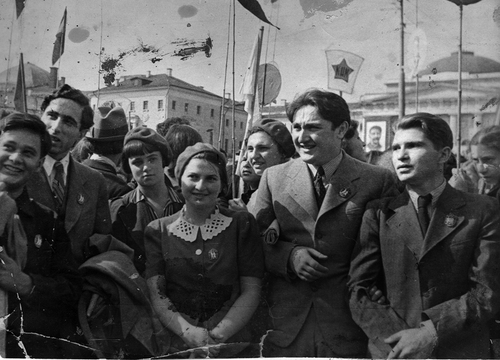 Tamarkina, who stands next to Flier, slightly behind. Tamarkina, who had just turned 20 when the picture was made, was already a laureate of several competitions. She was born in Kiev in 1920, started her studies there but moved to Moscow when she was 11, after being accepted into a special group for talented kids organized by Alexander Goldenweiser. At the age of 15 she won the first prize at the All-Union Performers’ competition. One year later she conquered the hearts of both the jury and the public while playing at the Chopin Competition in Warsaw. She was awarded the second prize, behind only Yakov Zak, who was seven years her senior. Heinrich Neuhaus, a jury member, talked about her as a mature, fully developed musician. After the Chopin, still a student, she was engaged to play concerts across the country; practically all of them were sold out.
Tamarkina, who stands next to Flier, slightly behind. Tamarkina, who had just turned 20 when the picture was made, was already a laureate of several competitions. She was born in Kiev in 1920, started her studies there but moved to Moscow when she was 11, after being accepted into a special group for talented kids organized by Alexander Goldenweiser. At the age of 15 she won the first prize at the All-Union Performers’ competition. One year later she conquered the hearts of both the jury and the public while playing at the Chopin Competition in Warsaw. She was awarded the second prize, behind only Yakov Zak, who was seven years her senior. Heinrich Neuhaus, a jury member, talked about her as a mature, fully developed musician. After the Chopin, still a student, she was engaged to play concerts across the country; practically all of them were sold out. 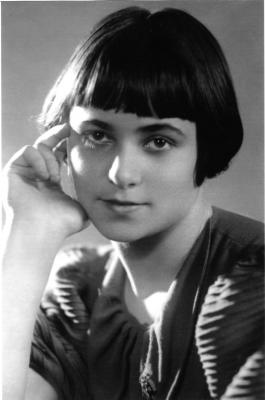 She was even awarded the order of the Barge of Honor and, at the age of 19, “elected” (“appointed” would be a better description) into the Moscow Soviet. Rosa married Emil Gilels in 1940 but it was not a happy union and in 1943 they divorced. In 1946 she fell ill; the diagnosis was terrible: Hodgkin's lymphoma. She continued performing, often with a high fever; the public didn’t know about her condition. Rosa Tamarkina died on August 5th of 1950 at the age of 30.
She was even awarded the order of the Barge of Honor and, at the age of 19, “elected” (“appointed” would be a better description) into the Moscow Soviet. Rosa married Emil Gilels in 1940 but it was not a happy union and in 1943 they divorced. In 1946 she fell ill; the diagnosis was terrible: Hodgkin's lymphoma. She continued performing, often with a high fever; the public didn’t know about her condition. Rosa Tamarkina died on August 5th of 1950 at the age of 30.
Next to Tamarkina stands Elizabeth Gilels, Emil’s younger sister. The family already had a pianist, so Elizabeth picked the violin as her instrument. Like Busya Goldshtein, she was a student of Peter Stolyarky, who also taught David Oistrakh, Nathan Milstein and many other talented violinists. When they were young, Elisabeth and Emil often played together. In 1935, just 16 years old, she took the Second prize, behind Oistrakh, at the 2nd All-Union Performers’ competition. In 1937, at the 1st Ysaÿe competition (it was later renamed as the Queen Elisabeth Competition) she took the 3rd prize. Again, Oistrakh was first and the Soviet violinists took all but one prizes from the first to the sixth. Four of the six were Stolyarsky’s students and the only non-Soviet violinist, Ricardo Odnoposoff, who took the 2nd prize, was from an Argentinian Russian-Jewish family. In 1949 Elizabeth married Leonid Kogan. Superb soloists, they created a duo and together recorded Bach, Vivaldi, and other composers. Elisabeth Gilels and Leonid Kogan had two children, Pavel and Nina. Pavel, also a brilliant violinist, eventually turned to conducting. Nina was a successful pianist and often played with her father. Pavel’s son Dmitry, also a violinist, died unexpectedly two months ago at the age of 38.
Yakov Zak, the second from the right, was 26 when this picture was made. He was born in Odessa, as was Goldshtein and the Gilelses. He graduated from the Odessa in 1932 and went to Moscow for post-graduate studies with Heinrich Neuhaus. In 1935 he took the third prize at the Second All-Union Performers’ Competition. Then, in 1937, he triumphed in Warsaw, winning the first prize at the Chopin Piano competition. Zak had a distinguished performing career; he was considered to be an intellectual pianist compared to, for example, the more “romantic” Flier. After the war he successfully performed in many countries across Europe and in the US. He was also one of the most respected professors at the Moscow Conservatory; among his students were Nikolai Petrov, Eliso Virsaladze, and Evgeny Mogilevsky. Zak died in Moscow in 1976.
And the serious young man on the right is, of course, Emil Gilels. We wrote about him not long ago.Permalink
October 30, 2017. An old picture. Last week, as we were looking for a good photograph of Emil Gilels, we came across this picture. It was taken during the May 1 celebrations in 1940; in it are six young musicians, all of great talent, aged 17 to 27. Young, happy, Jewish (those were the last pre-Antisemitic days of the Soviet Union), they are standing in a crowd on the Manezh Square, just outside of the Kremlin (behind them is Moscow University), smiling. 1940 was the year between two catastrophes, that of the Great Terror of 1937-38 and the war with Germany, which would invade the Soviet Union in a year. But in the meantime, they were living a rather privileged life: they made the young Soviet state proud, and the state responded with honors and good apartments. Who are they? Let’s start on the left and moveright. On the left is the youngest of them all, Busya (Boris) Goldshtein at 17. A violinist and a child prodigy, he was in in Odessa, and studied with Pyotr Stolyarsky. When Jascha Heifetz visited the Soviet Union in 1934, he met with many young violinists and singled Busya out. In 1935, at age 12 and a half, he won the fourth prize at the Henryk Wieniawski Violin Competition in Warsaw (Ginette Neveu was first, David Oystrakh came in second). Two years later, still not even 15, he received the fourth prize at the first Ysaye Competition in Brussels. During the war, being a student of the Moscow Conservatory, he, as many other musicians performed at the front line. This prevented him from timely passing the exam on a very important subject, “Brief History of the Communist Party.” So, despite his fame and honors, he was expelled from the Conservatory, which for all purposes was the end of his career. Goldstein emigrated to Germany in 1972 but never regained the status he held while a teenager.
standing in a crowd on the Manezh Square, just outside of the Kremlin (behind them is Moscow University), smiling. 1940 was the year between two catastrophes, that of the Great Terror of 1937-38 and the war with Germany, which would invade the Soviet Union in a year. But in the meantime, they were living a rather privileged life: they made the young Soviet state proud, and the state responded with honors and good apartments. Who are they? Let’s start on the left and moveright. On the left is the youngest of them all, Busya (Boris) Goldshtein at 17. A violinist and a child prodigy, he was in in Odessa, and studied with Pyotr Stolyarsky. When Jascha Heifetz visited the Soviet Union in 1934, he met with many young violinists and singled Busya out. In 1935, at age 12 and a half, he won the fourth prize at the Henryk Wieniawski Violin Competition in Warsaw (Ginette Neveu was first, David Oystrakh came in second). Two years later, still not even 15, he received the fourth prize at the first Ysaye Competition in Brussels. During the war, being a student of the Moscow Conservatory, he, as many other musicians performed at the front line. This prevented him from timely passing the exam on a very important subject, “Brief History of the Communist Party.” So, despite his fame and honors, he was expelled from the Conservatory, which for all purposes was the end of his career. Goldstein emigrated to Germany in 1972 but never regained the status he held while a teenager.
Next to him stands the pianist Yakov Flier, at 27 the eldest. Flier was born on October 21st, 1912, in Orekhovo-Zuyevo, a town outside of Moscow famous for its textile production but not its culture. Not at all a wunderkind, his talent developed slowly. After attending the Central music school, he was accepted at the Conservatory and studied there with one of the best professors, Konstantin Igumnov. He reached his full potential only by the end of his studies, but once at the top, he remained at the top as long as he could play. Starting 1935, he embarked on a series of concerts across the Soviet Union. In 1936 he won a piano competition in Vienna, ahead of his friend Emil Gilels, who took the second prize. Gilels would have his revenge two years later in Brussles, where he won the Ysaye while Flier was “only” the third. As early as in 1945 Flier noticed problems with his right hand; it was getting worse and by 1949 Flier could no longer play. He was absent from the concert scene for 10 years but returned in 1959 after a successful surgery and rehabilitation. While his earlier playing was romantic, sometimes too much so, it became deeper and more introspective. In 1960s and the 70s he toured in Europe and the US and became one of the most sought-after professors of the Moscow Conservatory.
Next to Flier, a step behind, stands the 18-year-old Rosa Tamarkina, fresh from a triumph at the Chopin competition. Why is she standing next to Flier, and not to Emil Gilels, whose wife she would become later that year? Is she still infatuated with Flier, as was rumored in Moscow? Why didn’t she marry him, one wonders – her marriage to Gilels was not very happy and brief, as, tragically, was her life. We’ll have to wait till next week to conclude our story about this remarkable group.Permalink
October 23, 2017. Emil Gilels. Last week we intended to write about the great Russian pianist, Emil Gilels but ran out of space. This week, even though we have several very interesting anniversaries, we’ll start with him. Emil Gilels was born in Odessa on October 19th of 1916. At that time, the musical Odessa was an amazing place. The whole school of violin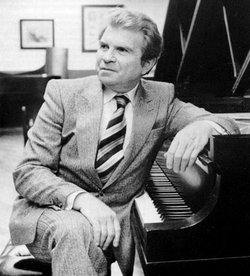 playing came out of Odessa: Pyotr Stolyarsky established it, and among his students were David Oistrakh, Nathan Milstein, Boris Goldstein, and Emil’s sister, Elizabeth Gilels. The pianists Benno Moiseiwitsch, Vladimir de Pachmann, Shura Cherkassky, Yakov Zak were all from Odessa. Sviatoslav Richter, though not born in Odessa, studied there. As most of the Odessa musicians, Emil Gilels was born into a Jewish family. His first teacher, at the age of five and a half, was Yakov Tkach (who, as Gilels acknowledged later, built the foundation of the pianist’s prodigious technique). Emil gave his first public concert at the age of 12. In 1930, not quite 14, he was accepted into the Odessa Conservatory, class of Berta Reingbald, whose other star pupil was Tatiana Goldfarb. In 1932 he met Arthur Rubinstein, who was visiting Odessa, and they became friends, even though Rubinstein was almost 30 years older. In 1933 Gilels won the first All-Union Performers’ Competition in Moscow and became famous overnight. He graduated from the Odessa Conservatory in 1935 and for the following three years studied with Heinrich Neuhaus in Moscow. He won several piano competitions, including the Concours Eugène Ysaÿe, Brussels, in 1938, and established himself as one of the most brilliant young pianists in the Soviet Union. Sergei Rachmaninov, then in the States, had heard about Gilels since his win in Moscow in 1933. After Brussels, many of Gilels’s performances were recorded, and Rachmaninov could listen to them on the radio. He decided that Gilels was his worthy successor, and sent him the Anton Rubinstein medal, which he received upon graduating from the Conservatory, and his Conservatory diploma. Gilels cherished these gifts for the rest of his life.
playing came out of Odessa: Pyotr Stolyarsky established it, and among his students were David Oistrakh, Nathan Milstein, Boris Goldstein, and Emil’s sister, Elizabeth Gilels. The pianists Benno Moiseiwitsch, Vladimir de Pachmann, Shura Cherkassky, Yakov Zak were all from Odessa. Sviatoslav Richter, though not born in Odessa, studied there. As most of the Odessa musicians, Emil Gilels was born into a Jewish family. His first teacher, at the age of five and a half, was Yakov Tkach (who, as Gilels acknowledged later, built the foundation of the pianist’s prodigious technique). Emil gave his first public concert at the age of 12. In 1930, not quite 14, he was accepted into the Odessa Conservatory, class of Berta Reingbald, whose other star pupil was Tatiana Goldfarb. In 1932 he met Arthur Rubinstein, who was visiting Odessa, and they became friends, even though Rubinstein was almost 30 years older. In 1933 Gilels won the first All-Union Performers’ Competition in Moscow and became famous overnight. He graduated from the Odessa Conservatory in 1935 and for the following three years studied with Heinrich Neuhaus in Moscow. He won several piano competitions, including the Concours Eugène Ysaÿe, Brussels, in 1938, and established himself as one of the most brilliant young pianists in the Soviet Union. Sergei Rachmaninov, then in the States, had heard about Gilels since his win in Moscow in 1933. After Brussels, many of Gilels’s performances were recorded, and Rachmaninov could listen to them on the radio. He decided that Gilels was his worthy successor, and sent him the Anton Rubinstein medal, which he received upon graduating from the Conservatory, and his Conservatory diploma. Gilels cherished these gifts for the rest of his life.
During WWII Gilels performed for the troops and, in 1944, premiered Prokofiev’s 8th piano sonata. In 1945, he formed a highly successful trio with Leonid Kogan (his brother in law – Kogan married his sister, the violinist Elizabeth) and the 23-year old Mstislav Rostropovich. After the war he became one of the first Soviet musicians to be allowed to travel and perform abroad (David Oistrach was another pioneer). Gilels played his American debut at the Carnegie Hall in October of 1955. Eugene Ormandy conducted the Philadelphia Orchestra. The performance of Tchaikovsky’s First Piano concerto was a triumph (both Rachmaninov and Horowitz also chose this concerto for their debuts). The rest of his US tour was equally successful. He returned to the States several times, and was always received equally well. Gilels was permitted to travel to other Western countries, a privilege not afforded to many Soviet musicians. He toured all over Europe and Japan playing with the greatest orchestras and conductors. Still, in the centralized Soviet Union, where everything had to be ranked, he was considered to be second to Sviatoslav Richter, as Kogan was considered second to Oistrakh, or Danill Shafran – to Rostropovich. These comparisons of course are nonsense, Gilels was second to no one, he was one of the greatest pianists of the 20th century. In 1981, after a concert at the Concertgebouw in Amsterdam Gilels suffered a heart attack. He never fully recovered and died on October 14th of 1985 in Moscow.
Gilels’s repertoire was phenomenally broad. He played “everything.” He was considered one of the greatest interpreters of Prokofiev’s piano sonatas. He recorded all of Beethoven’s piano concertos seven times. His Mozart was incomparable. Out of this treasure trove we’ll play just two sonatas of Domenico Scarlatti – and that’s because Scarlatti was also born this week, on October 26th of 1685. Here’s his sonata Sonata K.141, and here – Sonata K.533. Both were recorded live in London in 1957.Permalink
October 16, 2017. Galuppi. Franz Liszt was born this week and so was Charles Ives, but we’ve written about both extensively in the past. Luca Marenzio, a wonderful Italian madrigalist of the late Renaissance was also born this week, we celebrated him a year ago (here is his Là dove sono i pargoletti Amori, performed by Concerto Italiano, Rinaldo Alessandrini conducting). We’ve never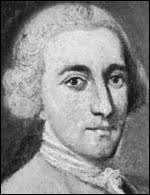 written about Baldassare Galuppi, though, and while he’s not one of the greats, he composed some very interesting music. Galuppi was born on October 18th of 1706 in Burano, an island in the Venetian lagoon almost as famous for its lace-making as Murano, an island nearby, is for its glass. Galuppi took music lessons with Antonio Lotti, the organist at San Marco. As a teenager he wrote an unsuccessful opera and at the age of 20 left Venice for Florence to work as a cembalist at the Teatro della Pergola. He returned to Venice in 1728 and continued composing and performing, although still without much success. In Venice of the time, Antonio Vivaldi ruled over the musical scene, and as for operas, Neapolitan productions were in vogue. In 1740 Galuppi was appointed the music director at the Ospedale dei Mendicanti, run by the Mendicanti friars. Mendicanti was an important institution, not just a hospital but also a school (especially for abandoned girls) and a shelter for lepers. Antonio Vivaldi’s father taught music there some years earlier. Galuppi’s responsibilities included teaching and composing. Less than a year into the contract with Mendicanti, Galuppi asked for permission to go to London. He stayed there for a year and a half and produced 11 operas, three of them his own. Apparently, Handel visited some of Galuppi’s productions. He returned to Venice in 1743; he continued composing operas, but his style was changing: in addition to opera seria (serious opera), in which he often cooperated with the famous librettist Metastasio, he tried himself in the new Dramma giocoso, (“drama with jokes”), the “new and improved” comic opera buffa. His new operas were more successful; Galuppi was also advancing professionally – in 1748 he was made the vice-maestro at San Marco. An even more consequential event took place a year later, when Galuppi started his collaboration with Carlo Goldoni, the famous playwright and librettist. In May of 1749, Galuppi wrote Arcadia in Brenta on Goldoni’ libretto. It was a big success, and by the end of the same year, they produced four more operas. Altogether, Galuppi and Goldoni created 18 more. Galuppi was so busy that he had to resign from Mendicanti. By the middle of the 1750s he was the most popular opera composer in all of Europe (Rameau and Gluck were probably very envious). In 1762, Galuppi was made maestro di capella of San Marco, the most important musical position in Venice.
written about Baldassare Galuppi, though, and while he’s not one of the greats, he composed some very interesting music. Galuppi was born on October 18th of 1706 in Burano, an island in the Venetian lagoon almost as famous for its lace-making as Murano, an island nearby, is for its glass. Galuppi took music lessons with Antonio Lotti, the organist at San Marco. As a teenager he wrote an unsuccessful opera and at the age of 20 left Venice for Florence to work as a cembalist at the Teatro della Pergola. He returned to Venice in 1728 and continued composing and performing, although still without much success. In Venice of the time, Antonio Vivaldi ruled over the musical scene, and as for operas, Neapolitan productions were in vogue. In 1740 Galuppi was appointed the music director at the Ospedale dei Mendicanti, run by the Mendicanti friars. Mendicanti was an important institution, not just a hospital but also a school (especially for abandoned girls) and a shelter for lepers. Antonio Vivaldi’s father taught music there some years earlier. Galuppi’s responsibilities included teaching and composing. Less than a year into the contract with Mendicanti, Galuppi asked for permission to go to London. He stayed there for a year and a half and produced 11 operas, three of them his own. Apparently, Handel visited some of Galuppi’s productions. He returned to Venice in 1743; he continued composing operas, but his style was changing: in addition to opera seria (serious opera), in which he often cooperated with the famous librettist Metastasio, he tried himself in the new Dramma giocoso, (“drama with jokes”), the “new and improved” comic opera buffa. His new operas were more successful; Galuppi was also advancing professionally – in 1748 he was made the vice-maestro at San Marco. An even more consequential event took place a year later, when Galuppi started his collaboration with Carlo Goldoni, the famous playwright and librettist. In May of 1749, Galuppi wrote Arcadia in Brenta on Goldoni’ libretto. It was a big success, and by the end of the same year, they produced four more operas. Altogether, Galuppi and Goldoni created 18 more. Galuppi was so busy that he had to resign from Mendicanti. By the middle of the 1750s he was the most popular opera composer in all of Europe (Rameau and Gluck were probably very envious). In 1762, Galuppi was made maestro di capella of San Marco, the most important musical position in Venice.
In 1764 Catherine the Great, the Empress of Russia, requested that Galuppi come to St.-Petersburg to be her court composer and conductor. Many Italians were working for Catherine, but Galuppi was reluctant; he agreed to go to Russia only on the condition that he retain his position at San Marco, of which he was assured by the Venetian authorities. After visiting C.P.E. Bach in Berlin, Galuppi arrived in St.-Petersburg in September of 1765. He stayed there for three years, composing two operas and two cantatas. He also gave weekly harpsichord concerts and conducted the court orchestra, which needed much work. As agreed, he stayed in St-Petersburg for three years and in 1768 returned to Venice. In his last years he wrote more secular music, but continued with the operas (in all, he wrote almost 100). Charles Burney, the British music historian of the time, who was acquainted with Galuppi, thought that “like Titian’s,” Galuppi’s work got better as he got older. He wrote his last opera, La serva per amore, in 1773. He died on January 3rd of 1785.
Opera was not the only genre in which Galuppi worked. He composed many masses and other sacred music. He also wrote a large number of keyboard pieces. Here’s his Sonata in C Major, performed by another great Italian, Arturo Benedetti Michelangeli. (A note: Emil Gilels was born on October 19th of 1916, we’ll write about him next week.)Permalink